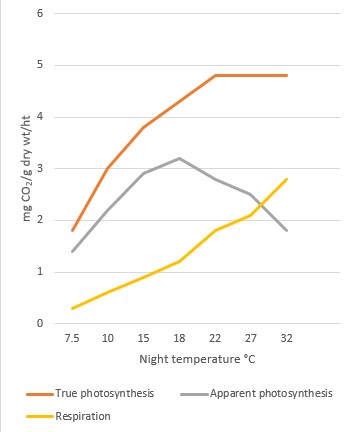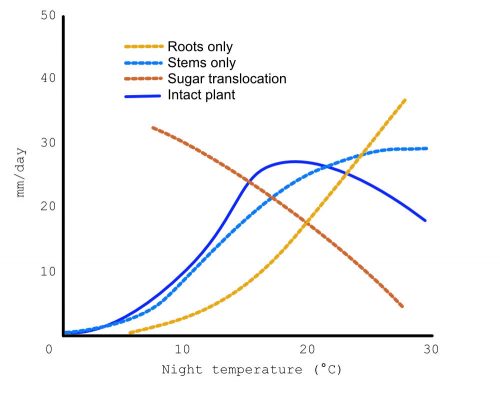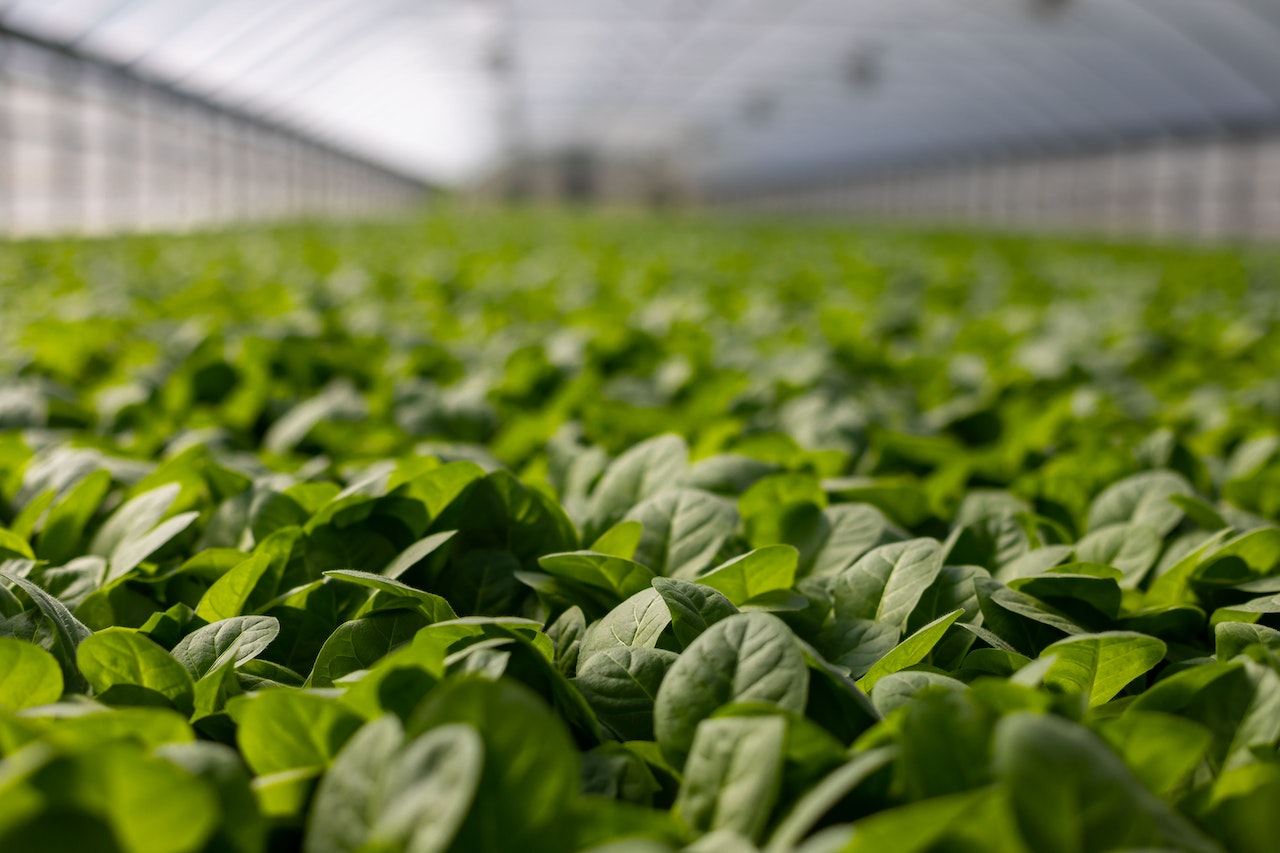The relationship between temperature and growth in greenhouses.
Factors determining plant temperature in a greenhouse.
Radiation or heat energy can be reflected, transmitted, absorbed, conducted, re-radiated or used to evaporate water. Evaporation requires more than 500 calories per gram of water evaporated. It is evident that if radiant energy is absorbed, plant temperature must increase until an equilibrium is reached at higher values. The new equilibrium temperature is determined by
- How much plants re-radiate thermal energy to their surroundings which depends on the temperature differential between plant and the surrounding area.
- By the removal of energy by conduction and convection processes (The flow of cooler air over warm leaves). The higher the air temperature, the closer the leaf temperature will be to the air temperature.
- How much energy is consumed by photosynthesis and other photo chemical processes.
- The evaporation rate or efficiency of the plant. 70-90% of water absorbed is used to cool the plant.
- The thermal heat capacity of the plant tissue and its mass. Thin leaves will have a faster rate of temperature change than thick leaves.
Crop temperature changes as it grows and changes shape, the season changes and sun’s position changes in the sky. Re-radiated heat from the soil diminishes as the crop canopy increases. The whole process is incredibly dynamic and there is hardly a day that is the same. Another aspect the grower must take into consideration is that higher leaf temperatures attract white fly to a greater extent that air temperatures1)Park, Jung-Joon & woo, Park & Shin, Key-Il & Cho, Kijong. (2011). Evaluation and Comparison of Effects of Air and Tomato Leaf Temperatures on the Population Dynamics of Greenhouse Whitefly (Trialeurodes vaporariorum) in Cherry Tomato Grown in Greenhouses. Wonye kwahak kisulchi = Korean journal of horticultural science and technology /. 29. 420-432.
During seedling stage, the maximum light interception inside the greenhouse is on the soil surface. The highest air temperature will be close to the ground. Re-radiation during the night cools the soil down till just before sunrise when it is at its lowest temperature. As the leaf canopy expands, maximum light interception will take place where the leaf area index (LAI) is the highest, which is also where the highest temperature will be. Hall and Hanan (1976)2)Hall, A., Hanan, J.J. Measurement of total light energy in a carnation bench. Colo. Flowers Growers Association Bull. 308, 2 (1976). found that for a one year old carnation crop, the light energy was insignificant at 500mm above the soil surface. With a crop of 1250mm high, the total energy received was only 31% of that outside, 125mm from the vertical outside surfaces of the crop, 900mm above the ground.
The above data explains why crops with dense leaf canopies lose the lower leaves close to maturity. It is also the lower leaves that are more susceptible to diseases and why it is recommended to remove them. It is not only the vertical temperature differential but also the wind velocity, humidity and carbon dioxide concentrations that vary. All these changes have an effect on the micro-climate around the plant leaves which affects growth. Once a crop has filled a space to which it is confined, its productivity ceases to be a function of the number of plants per square meter and it is a function of leaf area expose to radiant energy.
No matter what ventilation system you use, plant response remains a partial function of position in the greenhouse. There is always a difference in yield between the center rows and side rows in a greenhouse. Greenhouse orientation has a significant effect on yields. In the southern hemisphere the northern side of a greenhouse will always perform better than the southern side. The reason for these results are due to light variations in the greenhouse and the amount of sunlight intercepted.
There will always be temperature variations in a greenhouse. The extent of the variation will depend on the cooling or heating system, its arrangement (lengthwise or across), wind direction and velocity, greenhouse orientation and type of structure and crop type and growth stage. Eliminating temperature differential between pad and fan has diminishing returns up to a point where it is no longer feasible. It will always be a compromise between ROI and potential future crops and the efficacy of the system. Increasing vantilation rates without cooling pads has its limits. High ventilation rate with cooling pads are the most effective in cooling down plants in the greenhouse3)Willits, D.H.. (2000). The Effect Of Ventilation Rate, Evaporative Cooling, Shading and Mixing Fans On Air and Leaf Temperatures In A Greenhouse Tomato Crop. 2000 ASAE Annual Intenational Meeting, Technical Papers: Engineering Solutions for a New Century. 2. 4207-4225.
It is not financially feasible to maintain the same temperature throughout the whole greenhouse for significant periods. To put it bluntly, it’s impossible. Optimum air temperatures mentioned in literature and brochures actually mean the average air temperature as measured in the middle of a greenhouse under the average growth conditions gave the greatest average return over an extended period of time. The yield could be anything from actual yield, marketable yield, time to flower etc. Optimum growth temperatures is a broad generalization covering all possible eventualities that the seed companies and greenhouse companies cannot be sued if you have a crop failure. Actual plant temperatures will differ in each location with different micro and macro climates, greenhouse design, greenhouse covering, cooling systems and geographical location. Unfortunately it boils down to experience and to gain sufficient empirical information which is combined to provide reasonable estimates of what the “optimum temperature” must be for a specific crop, in a specific greenhouse during a specific season. Optimum temperature claims remain nebulous.
Wise growers have an awareness of their greenhouses. Through patient observation and learning, planning becomes an instinct. Heat tolerant varieties are placed in the warmest areas in the greenhouse, crops sensitive to light are placed in lighter areas and pruned carefully. In pot plant productions, temperature differentials may be utilized by moving the crop to various areas in order to hasten, delay or hold for sale.
Temperature effects on plant growth processes
Crop yield depends on the basic physiological processes such as photosynthesis, respiration, translocation, ion update, transpiration, pigment formation, reproduction, bulb formation and many other. The diurnal changes of temperature has a direct and indirect affect on all these processes. Stalfelt’s (1937) relationship between temperature and the rate of respiration compared with true photosynthesis is a classic example (Figure 1). over a limited range at which plant growth will occur, chemical processes will commonly be doubled for every 10°C rise in temperature. Respiration shows a continuous rise as temperature increases and also does photosynthesis. But, photosynthesis can also be limited by available energy and CO2 levels. As respiration is the utilization of materials provided by photosynthesis to build the plant, high enough temperature is possible for many plants where there is a net decrease in the sugar production.

Too high temperatures and low light cause weak and spindly growth. This is the most basic example of the interaction between light and temperature. it’s important to remember that temperature affects physical processes such as transpiration. However, increasing temperature and humidity will not increase transpiration as much as when humidity is kept relatively low. Interestingly, if the soil temperature is low, ion uptake and root growth is reduced. It is possible that with extreme low soil temperatures, above ground growth will stop, regardless of air temperature. Prolonged low soil temperatures, where root growth is restricted, the leaves will show either Boron deficiency and or Calcium deficiency since both these elements are absorbed in the meristematic root tips.
Temperature will have a different effect on the various processes that are involved with elongation of various plant parts. For instance, a 20°C night temperature might result in 15mm elongation of some roots, but shoots might grow only 5mm. We are again reminded of the optimum average temperature that will give the grower the highest return on economic inputs (Figure 2).

Monitoring, maintaining and measuring temperatures in a greenhouse is more an art than science, but the growers approach must be scientific. Haphazard approaches will always be punished by nature, right into your bank account. The ideal is to optimize climate inside the greenhouse with automated systems 5)Alsadon, Abdullah & Al-Helal, I. & Derahim, Abdullah & Shady, M.R. & Al-Selwey, Wadei. (2020). Growth analysis of tomato plants in controlled greenhouses. Acta Horticulturae. 177-184. 10.17660/ActaHortic.2020.1271.25., but that can be expensive.
Main image by Mark Stebnicki. 6)Photo by Mark Stebnicki: https://www.pexels.com/photo/selective-focus-photo-of-plants-2749165/
References
| ↑1 | Park, Jung-Joon & woo, Park & Shin, Key-Il & Cho, Kijong. (2011). Evaluation and Comparison of Effects of Air and Tomato Leaf Temperatures on the Population Dynamics of Greenhouse Whitefly (Trialeurodes vaporariorum) in Cherry Tomato Grown in Greenhouses. Wonye kwahak kisulchi = Korean journal of horticultural science and technology /. 29. 420-432. |
|---|---|
| ↑2 | Hall, A., Hanan, J.J. Measurement of total light energy in a carnation bench. Colo. Flowers Growers Association Bull. 308, 2 (1976). |
| ↑3 | Willits, D.H.. (2000). The Effect Of Ventilation Rate, Evaporative Cooling, Shading and Mixing Fans On Air and Leaf Temperatures In A Greenhouse Tomato Crop. 2000 ASAE Annual Intenational Meeting, Technical Papers: Engineering Solutions for a New Century. 2. 4207-4225. |
| ↑4 | Stålfelt, M.G. Der Gasaustausch der Moose. Planta 27, 30–60 (1937). |
| ↑5 | Alsadon, Abdullah & Al-Helal, I. & Derahim, Abdullah & Shady, M.R. & Al-Selwey, Wadei. (2020). Growth analysis of tomato plants in controlled greenhouses. Acta Horticulturae. 177-184. 10.17660/ActaHortic.2020.1271.25. |
| ↑6 | Photo by Mark Stebnicki: https://www.pexels.com/photo/selective-focus-photo-of-plants-2749165/ |



